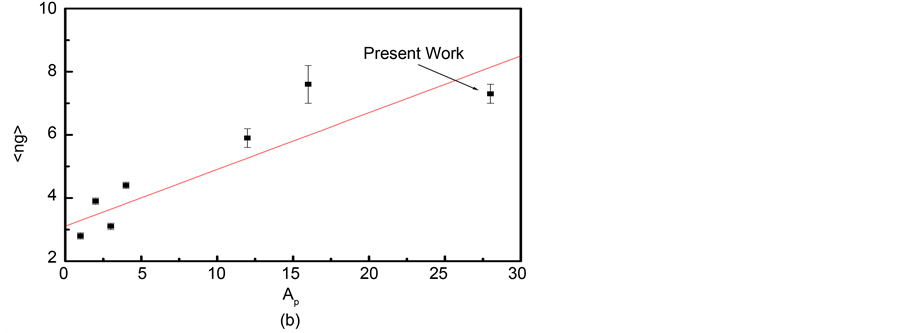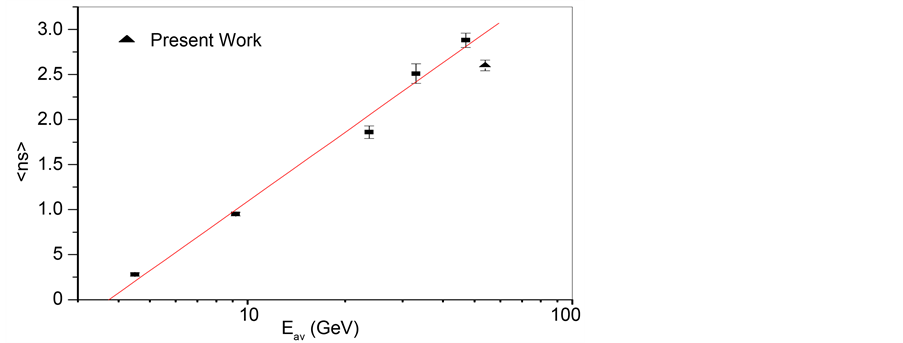Journal of Modern Physics
Vol.07 No.12(2016), Article ID:70090,6 pages
10.4236/jmp.2016.712137
Complete Destruction of Ag Br Emulsion Nuclei BY28Si Ions with 4.5 GeV/Nucleon Energy
A. Abd EL-Daiem
Physics Department, Faculty of Science, Sohag University, Sohag, Egypt

Copyright © 2016 by author and Scientific Research Publishing Inc.
This work is licensed under the Creative Commons Attribution International License (CC BY).
http://creativecommons.org/licenses/by/4.0/



Received 4 July 2016; accepted 22 August 2016; published 25 August 2016
ABSTRACT
The main experimental characteristics (multiplicity characteristics) of secondary particles have been investigated in interactions of 28Si with emulsion at 4.5 GeV/c per nucleon at rest of emulsion, nuclei. The complete destruction of the heavy target nuclei (Ag, Br) has been studied. The average of shower particles
Keywords:
Multiplicity Characteristics, Probability and Energy Available

1. Introduction
The study of the phenomena of complete destruction of heavy target nuclei is very interesting. This interest stems from the fact that most of these interactions are due to central collisions. The central collisions provide a unique opportunity to investigate the consequences of nuclear compression, such as hydrodynamic effects [1] - [4] . In addition, there is a good possibility to obtain valuable information on the excitation and consequent decay of residual target nucleus. A detailed and systematic study of this phenomenon was carried out in [5] . In this work the criterion nh ≥ 28, since [nh = (ng + nb) gray particles and black particles] was used to select events of complete destruction of (Ag, Br) nuclei. Nowadays, there are huge amounts of data concerning the study of this phenomenon. Different beam nuclei at various energies have been used in the experiments. There are two main directions for the interpretation of the experimental results of complete destructions. The first direction considers such events as a tail in the multiplicity distribution which can be accounted for by the cascade evaporation process inside the target nucleus. The second one implies a one-step like process which occurs due to the collectivity of the target nucleons together. In the present work, we study complete destruction nh ≥ 28 of (Ag, Br) emulsion nuclei induced by 4.5 A GeV/c 28Si nuclei. The average multiplicities of the different emitted charged particles have been compared with the corresponding experimental values obtained from the interactions of different types of nuclei with emulsion at the same incident momentum per nucleon. The energy available in the centre of mass system for the complete destruction of the target nucleus has been studied for different projectiles. The multiplicity correlations between the charged secondaries produced in these interactions and both the mass number of the projectile and the available energy have also been analyzed. The previous detailed analysis [6] has shown that the selection criterion nh ≥ 28 corresponds to the complete destruction of the target nucleus, nearly, into individual nucleons and light fragments leaving no measurable residual nucleus.
2. Experimental Techniques
Nuclear emulsions of the type BR-2 were exposed to 4.5 A GeV/c 28Si beams at the Dubnasynchrophasotron. The pellicles of emulsion have the dimensions of 20 cm × 10 cm × 600 µm (undeveloped emulsion). The intensity of the beam was ~104 particles/cm2 and the beam diameter was approximately 1 cm. Along the track, a double scanning has been carried out fast in the forward direction and slow in the backward one. In the measured interactions, all the charged secondary particles have been classified according to the range L in the emulsion and the relative ionization g* = g/g0, where g is the particle track ionization and g0 is the ionization of a relativistic shower track in the narrow forward cone of an polar angle θ ≤ 3˚, (the polar angle θ of each track, i.e. the space angle between the direction of the beam and that of the given tracks) into the following groups:
1) Shower tracks of produced particles, “s-particles”; have a relative ionization g* ≤ 1.4; these tracks have an emission angle θ ≤ 3˚; they have been further subjected to multiple scattering measurements for momentum determination in order to separate the produced pions from the single charged projectile fragments. 2) Grey tracks of produced particles, “g-particles”, having a relative ionization (1.4 ≤ g* < 10) and L > 3 mm. 3) Black tracks of produced particles, “b-particles”, having L ≤ 3 mm. 4) The b and g tracks, taking together, are both called heavily ionizing particles, “h-particles”.
3. The Multiplicity Characteristics
To investigate the dependence of the average multiplicity
In these reactions, the momentum per incident nucleon is constant and it equals 4.5 GeV/c. The experiments were carried out under the same conditions. Figure 1(a) and Figure 1(b) show the dependence of the average multiplicities
 (1)
(1)
where i = s or g. The values of the coefficients ai are 0.39 ± 0.05 and 0.18 ± 0.01 and ai are 2.21 ± 0.66 and
Table 1. The average multiplicities
Figure 1. Projectile mass number for different elements at 4.5 GeV/c per Nucleon: (a) versus
3.11 ± 0.06 for shower and grey particles respectively. This result agrees with the fact that the interaction cross section is proportional to  and is proportional to
and is proportional to  from
from
4. Probability of Complete Destruction of Target Nuclei
In the present work, the probability of complete destruction of (Ag, Br) emulsion nuclei p is defined as the ratio between the number of events of nh ³ 28 to the total number of inelastic interactions of the incident particle with (Ag, Br) nuclei. Figure 2 illustrates the dependence of the probability p on Ap for various projectile nuclei, all at 4.5 A GeV/c. It is seen that the probability p increases linearly with  up to the carbon nucleus. The values of the probability p, predicted by the cascade evaporation model [8] , are larger than the corresponding experimental values. Moreover, the behavior of probability p versus Ap in the present experiment does not agree with the calculations of the cascade evaporation model.
up to the carbon nucleus. The values of the probability p, predicted by the cascade evaporation model [8] , are larger than the corresponding experimental values. Moreover, the behavior of probability p versus Ap in the present experiment does not agree with the calculations of the cascade evaporation model.
5. Energy Available
For the events having nh ≥ 28, and implying the complete destruction of the target nuclei, the relation between
 , (2)
, (2)
where Mp, is the projectile rest mass in GeV and  where p0 is the projectile momentum in
where p0 is the projectile momentum in
GeV/c. The effective target mass Mt is equal to , where m = 0.931 GeV. The relation between
, where m = 0.931 GeV. The relation between
Figure 2. The probability, p, of complete destruction of (Ag, Br) nuclei due to the interactions of different projectile at 4.5 GeV/c per nucleon.
Figure 3. The average multiplicity of shower particles
and the energy available in the centre of mass system, Eav, for different projectiles at the same incident momentum, which shows that as the projectile mass number increases, Eav increases and consequently
 (3)
(3)
with A = −13.09 and B = 11.46.
6. Multiplicity Correlation in Complete Destruction of 28Si Ions
In the present work, we studied the correlation of complete destruction (nh ≥ 28) of (Ag, Br) emulsion nuclei induced by 4.5 A GeV/c 28Si nuclei. The probability of complete destruction of AgBr nuclei different projectile at various energies is shown in [11] . The correlation in complete destruction dependencies between the charge particle multiplicities allows us to discuss the mechanism of nucleus-nucleus interactions. The dependencies
Figure 4. The correlations between the secondary particles multiplicities for complete destructions (events with nh > 28) in Si28 interactions with emulsions.
Table 2. Results of approximate fit of the experimental data for the multiplicity correlation from complete destruction in 28Si ions interactions with emulsion using the dependence
disintegration of the target does not depend strongly on the number of shower particles. One can observe the correlation between the fast and the slow stages of the inelastic interactions of tow nuclei by studying the dependencies
7. Conclusion
From the present study, one may concluded that the average number of the shower particles is proportional to 

Cite this paper
A. Abd EL-Daiem, (2016) Complete Destruction of Ag Br Emulsion Nuclei BY28Si Ions with 4.5 GeV/Nucleon Energy. Journal of Modern Physics,07,1506-1511. doi: 10.4236/jmp.2016.712137
References
- 1. Abd-Allah, N.N. (1993) Physica Scripta, 47, 501-504.
- 2. Antonchik, V.A., et al. (1984) Soviet Journal of Nuclear Physics, 39, 774.
- 3. Sherif, M.M. and Mohery, M. (1991) Egyptian Journal of Physics, 22, 125.
- 4. Bogdanov, V.G., et al. (1983) Soviet Journal of Nuclear Physics, 38, 909.
- 5. Barashnikov, V.S. and Belyakov, V.A. (1959) Van-shu-fen: Communication of JINR pI-331, Dubna.
- 6. Tolstov, R.A. and Krashmukhamedov, R.A. (1995) Complete Destruction of Ag Br Nuclei. Communication of JINR pI6897, Dubna.
- 7. Ameeva, B.U., et al. (1987) Preprint No. 87-09 of the Institute of High Energy Physics. Academy of Science of Kazakhsahoi SSR, Alma-Ata.
- 8. Beavis, D., et al. (1986) Phys., 34, 757-760.
- 9. Csernai, L.P., et al. (1986) Physical Reviews, 34, 1270-1273.
- 10. Beckmann, P., et al. (1987) Modern Physics Letters A, 2, 163.
http://dx.doi.org/10.1142/S0217732387000215 - 11. Beavis, D., et al. (1985) Physical Review Letters, 54, 1652.
http://dx.doi.org/10.1103/PhysRevLett.54.1652







